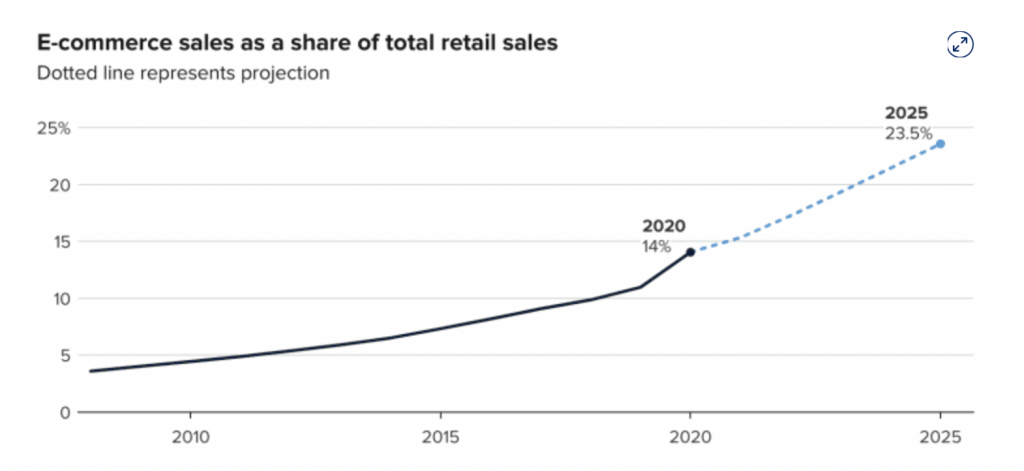Amazon is expected to account for more than 40 percent of e-commerce sales in the U.S. by the end of 2021, up from 3.6 percent in 2008 and 14 percent in 2020. Citing data from EMarketer, CNBC states that behind Amazon, Walmart – which lost its “top apparel retailer” title to Amazon this spring and is slated to also give up its position as the largest U.S. retailer to Amazon in 2022 – will likely generate 7 percent of all digital retail sales by the end of the year, with eBay, Apple, Home Depot, Target and Best Buy lagging behind. The news comes as Amazon is on track to generate some $12.18 billion in U.S. sales for its annual Prime Day event, up 17.3 percent year-over-year basis.
“Amazon’s dominance on the internet has only grown as shopping online becomes second nature for many consumers,” according to CNBC, something that has been helped along by COVID-19, which served to accelerate a larger shift to e-commerce spending that was underway before the onset of the pandemic. Online footwear and retail sales have, of course, played a notable role in Amazon’s rise, with Wells Fargo estimating in March that Amazon’s sales in the U.S. in these categories grew by approximately 15 percent in 2020 to more than $41 billion, thereby, making it the holder of an 11 to 12 percent share of the U.S. apparel market and an even greater 34 to 35 percent share of all apparel sold online.

“To put this in perspective, Amazon sold almost 7 times as much apparel/footwear as Macy’s,” which is the second largest player online, according to Wells Fargo’s analysts. (Macy’s generated $7.71 billion in online sales in 2020, and expects to reach $10 billion in online sales by 2023). To put Amazon’s fashion-specific might into perspective even further: Amazon’s apparel and footwear sales are about 20 percent to 25 percent greater than Walmart’s, and are expected to grow even further – to more than $45 billion – this year.
Looking beyond the U.S., where Amazon has made no secret of its ambitions in the apparel – and even luxury – space, the Jeff Bezos-founded behemoth is betting big on India, where e-commerce sales are expected to top $85 billion by 2024, and where the New York Times says that Amazon already accounts for about one-third of e-commerce sales. Expansion in India has not been without setbacks, as evidenced by “tighter foreign investment rules and antitrust cases,” per Reuters, and the legal battles that Amazon has waged in Indian courts in a quest to put a stop a $3.4 billion deal between retail titan Future Group – in which Amazon acquired a stake in 2019 in exchange for $200 million – and conglomerate Reliance Industries, which call into question Amazon’s future in the key growth market.
Nonetheless, on the apparel and fashion front, Amazon has fared well in India. Mint, an Indian financial daily newspaper, reported this month that Amazon saw 40 percent growth for the 2020 fiscal year within in its fashion division, and 45 percent increases in apparel order volumes, which was positively impacted by the pandemic-prompted closure of brick-and-mortar stores. Also worth noting: a large portion of this growth came from India’s smaller cities, with 118 percent of volume growth coming from tier-2 cities, and 192 percent from tier-3 cities.
These figures tie into the overarching expectation that second and third tier cities will drive retail growth in India in a post-pandemic capacity, as these markets have witnessed “faster evolution in growth in disposable income, mobile internet, and support infrastructure.” Looking specifically at fashion and luxury goods brands, consulting firm Kearney notes that most companies have already established a “strong presence in metros and tier-1 cities,” making it so that the “next wave of growth in retail will be led by emerging cities beyond tier 1 and emerging hotspots within metros and tier 1.” The same seems to apply to Amazon, as well.
Saurabh Srivastava, the director and head of Amazon Fashion India, told Mint that “fashion and beauty are among the largest categories for Amazon in India and also the fastest growing category in terms of acquiring new customers for Amazon India as one out of every three new customers starts her shopping journey with Amazon Fashion.” In terms of “top cities,” she name-checked ones outside of tier-1, including Bengaluru, Mumbai, Pune, Hyderabad, Kanchipuram, Gurgaon, Chennai, Kolkata, Ahmedabad, and Lucknow among others, as exercising “increased penetration and coverage of online shopping.”
Reflecting on Amazon’s efforts in India, Brad Stone, the author of the new book “Amazon Unbound: Jeff Bezos and the Invention of a Global Empire,” recently told Marketplace Morning report that “there’s really been no limit to the size of the investment that Amazon has been willing to make to dominate this market,” and there is no end in sight.











